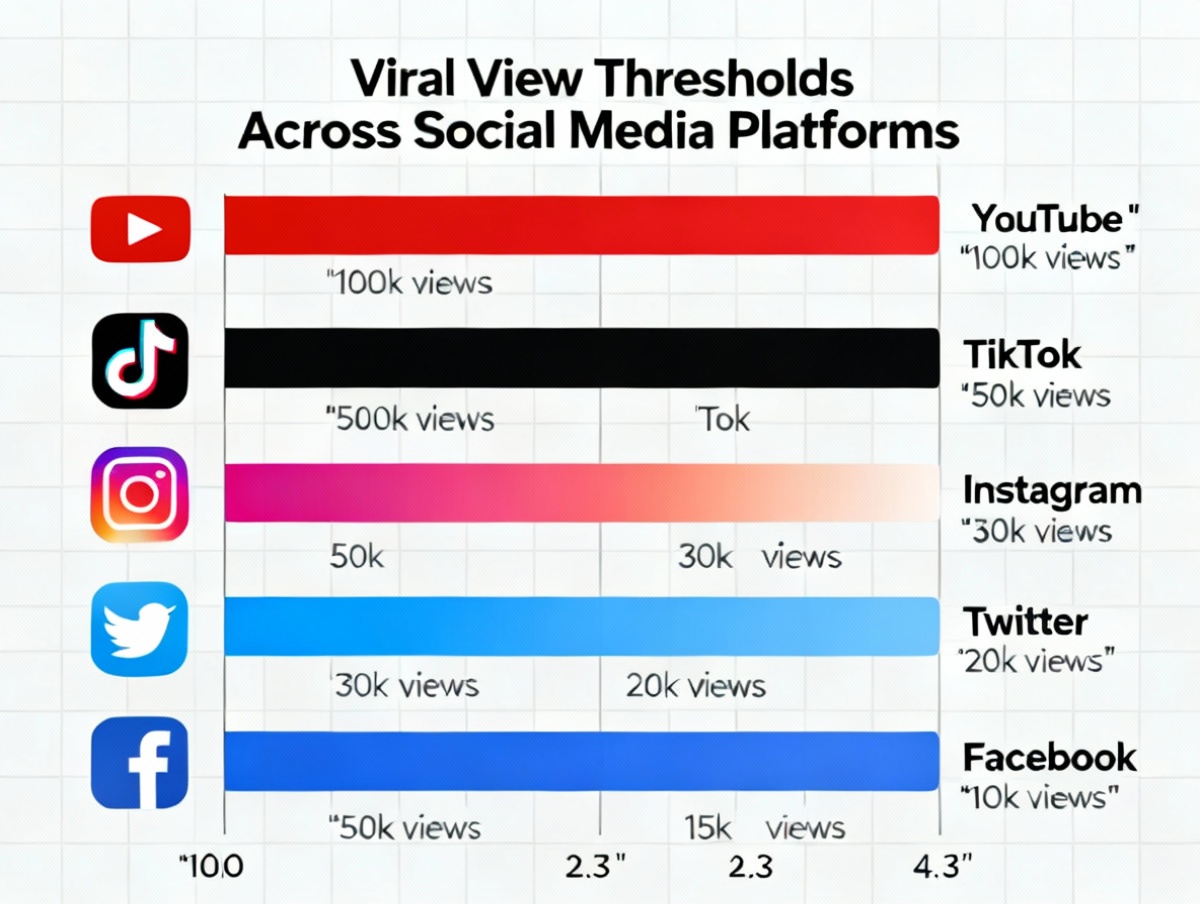how many views is viral
How Many Views Is Considered Viral? Understanding Viral Content in the Digital Age
Published on October 14, 2025

Table of Contents
- Introduction: The Fascination with Viral Content
- What Does 'Viral' Really Mean?
- How Many Views Is Considered Viral?
- Viral Thresholds by Platform
- Key Factors That Drive Virality
- Case Studies: Viral Content in Action
- The Role of Algorithms in Virality
- Common Myths About Going Viral
- Tips for Creating Viral-Ready Content
- Measuring Success Beyond Views
- Conclusion: The Evolving Nature of Virality
Introduction: The Fascination with Viral Content
In the digital age, the term "viral" has become part of everyday language. Whether it's a dance challenge sweeping TikTok, a meme dominating Twitter, or a heartfelt story shared across Facebook, viral content captures the imagination of millions. But why are we so fascinated by viral moments?
Viral content represents the pinnacle of digital influence. For creators, it’s the holy grail—a sign that their message has resonated far beyond their immediate audience. For brands, virality can mean instant recognition, increased sales, and a surge in followers. For audiences, viral content is often a shared cultural experience, a moment of collective participation in the digital zeitgeist.
But beneath the surface, virality is more than just numbers. It’s about connection, emotion, and the unpredictable nature of online communities. Understanding what makes content go viral—and how many views it actually takes to get there—can unlock new possibilities for anyone looking to make an impact online.
What Does 'Viral' Really Mean?
The word "viral" traces its roots to the world of biology, where a virus spreads rapidly from person to person. In the digital context, "going viral" describes content that spreads quickly and widely across the internet, reaching audiences far beyond its original scope.
The Evolution of Virality
Originally, virality was associated with email chains and early internet memes—think of the dancing baby GIF or the "All Your Base Are Belong To Us" phenomenon. As social media platforms emerged, the mechanics of virality evolved. Sharing became instantaneous, and the potential reach of a single post grew exponentially.
Today, virality is not just about speed, but also about scale and impact. A viral video on YouTube might rack up millions of views in days, while a tweet could spark global conversations within hours. The definition of "viral" has become more nuanced, shaped by platform algorithms, audience behaviors, and cultural trends.
The Subjectivity of Virality
Importantly, what’s considered viral can vary dramatically depending on context. For a small creator, 10,000 views might feel viral. For a major brand, the threshold might be in the millions. Virality is as much about exceeding expectations as it is about raw numbers.
How Many Views Is Considered Viral?
This is the question at the heart of digital content creation: How many views does it take for something to be considered viral?
General Benchmarks
There is no universal answer, but certain benchmarks have emerged:
- 10,000 Views: For niche communities or new creators, this can be a significant milestone and may be considered "viral" within that context.
- 100,000 Views: At this level, content is likely reaching beyond the creator’s immediate audience and being shared organically.
- 1,000,000+ Views: This is the classic benchmark for virality on major platforms. Content with a million views is almost always considered viral, especially if achieved in a short time frame.
Why the Numbers Vary
Several factors influence what counts as viral:
- Platform Norms: Different platforms have different audience sizes and engagement rates.
- Niche vs. Mainstream: Content in a small niche can be "viral" with far fewer views than mainstream content.
- Time Frame: Speed matters. 100,000 views in an hour is more "viral" than the same number over a month.

The Role of Engagement
Views are just one part of the equation. Shares, comments, and likes can be even more telling indicators of virality, as they reflect active participation rather than passive consumption.
Viral Thresholds by Platform
Each social media platform has its own culture, audience size, and algorithmic quirks. As a result, the threshold for what’s considered viral varies widely.
YouTube
On YouTube, a video is often considered viral if it surpasses 1 million views within a short period. However, for smaller channels, even 100,000 views can be a viral moment. Engagement metrics like watch time and shares also play a crucial role in how the platform surfaces content.
TikTok
TikTok’s algorithm is designed to give new content a chance to shine. A video can go viral with as few as 250,000 to 500,000 views, especially if it garners high engagement quickly. For established creators, the bar might be higher, but the platform’s rapid-fire nature means virality can happen overnight.
On Instagram, virality is often measured by both views and shares. A post or Reel with 100,000+ views and high engagement (likes, comments, shares) is typically considered viral. Stories can go viral through widespread sharing and reposting.
Facebook’s massive user base means the viral threshold is higher. Posts with 500,000+ views or shares are often considered viral, but context matters. Local community groups may see virality at much lower numbers.
Twitter (X)
On Twitter, virality is measured more by retweets and likes than by views. A tweet with 10,000+ retweets or 100,000+ likes is usually considered viral, though trending topics can amplify reach even further.

Platform Comparison Table
| Platform | Viral View Threshold | Key Engagement Metric |
|---|---|---|
| YouTube | 1,000,000+ | Watch time, shares |
| TikTok | 250,000–500,000+ | Shares, comments, likes |
| 100,000+ | Shares, saves, likes | |
| 500,000+ | Shares, comments | |
| 10,000+ retweets/100,000+ likes | Retweets, likes |
Key Factors That Drive Virality
While view counts are important, the real magic of virality lies in the factors that compel people to share content.
1. Emotional Resonance
Content that evokes strong emotions—joy, surprise, awe, anger, or even sadness—is more likely to be shared. Emotional impact creates a personal connection, prompting viewers to pass it along.
2. Shareability
Easy-to-share formats (short videos, memes, infographics) and clear calls to action increase the likelihood of content spreading. The simpler it is to share, the faster it travels.
3. Relatability
Content that reflects shared experiences or common frustrations often goes viral because people see themselves in it. Relatable humor, life hacks, and everyday observations are prime examples.
4. Timing
Posting at the right moment—whether it’s during a trending topic, a cultural event, or even just peak hours—can dramatically increase the chances of virality.
5. Novelty and Surprise
Unexpected twists, creative formats, or unique perspectives catch people off guard and encourage them to share with others.
6. Community and Trends
Participating in trending challenges, hashtags, or memes can give content a viral boost by tapping into existing momentum.
Case Studies: Viral Content in Action
Examining real-world examples provides insight into the diverse paths to virality.
The Ice Bucket Challenge (Facebook)
The ALS Ice Bucket Challenge became a global phenomenon, raising awareness and millions of dollars for ALS research. Its success was driven by a simple, participatory format and the power of social nomination.
"Charlie Bit My Finger" (YouTube)
This home video of two brothers became one of YouTube’s earliest viral hits, amassing hundreds of millions of views. Its charm lay in authenticity and universal humor.
TikTok Dance Challenges
Short, catchy dance routines—like the "Renegade"—have repeatedly gone viral on TikTok, propelled by music, trends, and the platform’s remix-friendly features.
Twitter Hashtag Movements
Hashtags like #BlackLivesMatter have gone viral, not just as memes but as powerful tools for social change, demonstrating that virality can have real-world impact.
Lessons Learned
- Participation fuels spread: Challenges and hashtags invite user involvement.
- Authenticity resonates: Genuine moments often outperform scripted content.
- Timing is crucial: Aligning with cultural moments amplifies reach.
The Role of Algorithms in Virality
No discussion of virality is complete without addressing the invisible hand of algorithms.
How Algorithms Shape What We See
Social media platforms use complex algorithms to determine which content appears in users’ feeds. These systems prioritize content based on factors like engagement, relevance, and recency.
- YouTube: Recommends videos based on watch time, click-through rate, and user history.
- TikTok: Surfaces content on the "For You" page based on early engagement and completion rates.
- Instagram: Prioritizes posts with high engagement and relevance to the user.
- Facebook: Boosts posts that generate meaningful interactions.
- Twitter: Highlights tweets with rapid engagement and trending hashtags.
Amplification and Limitation
Algorithms can amplify content by exposing it to larger audiences, but they can also limit reach if engagement drops. This creates a feedback loop—content that performs well early on is shown to more people, increasing its chances of going viral.
The Element of Chance
While creators can optimize for algorithms, there’s always an element of unpredictability. Sometimes, the right piece of content simply hits at the right time.
Common Myths About Going Viral
Virality is surrounded by myths and misconceptions. Let’s debunk a few:
Myth 1: Virality Is Pure Luck
While luck plays a role, most viral content is the result of strategy, timing, and understanding audience psychology.
Myth 2: Only Certain Content Types Go Viral
Any type of content—videos, tweets, images, even long-form articles—can go viral if it resonates with people.
Myth 3: Virality Equals Long-Term Success
A viral moment doesn’t guarantee sustained attention or growth. Many creators experience a spike in views followed by a return to normalcy.
Myth 4: You Need a Huge Following to Go Viral
Platforms like TikTok have proven that even new creators can achieve virality thanks to algorithmic recommendations.
Myth 5: Going Viral Is Always Positive
Not all viral attention is good. Negative or controversial content can go viral, sometimes with unintended consequences.
Tips for Creating Viral-Ready Content
While there’s no guaranteed formula, certain practices can increase your chances of going viral.
1. Craft a Compelling Hook
Grab attention in the first few seconds. Whether it’s a striking visual, a provocative statement, or a surprising fact, the hook is crucial.
2. Leverage Trends and Challenges
Participate in trending topics, hashtags, or challenges relevant to your niche. This increases discoverability and taps into existing momentum.
3. Optimize for Engagement
Encourage viewers to like, comment, and share. Ask questions, invite participation, and create content that sparks conversation.
4. Keep It Short and Shareable
Short-form content is easier to consume and share, especially on platforms like TikTok and Instagram.
5. Tell a Story
Narrative-driven content is memorable and emotionally engaging. Even a short video can tell a powerful story.
6. Use High-Quality Visuals
Clear, visually appealing content stands out in crowded feeds.
7. Post at the Right Time
Analyze your audience’s activity and post when they’re most likely to be online.
8. Collaborate with Others
Partnering with other creators or influencers can expand your reach and introduce your content to new audiences.
Measuring Success Beyond Views
While view counts are the most visible metric, true viral success goes deeper.
Engagement Metrics
- Shares: Indicate that viewers found the content valuable enough to pass along.
- Comments: Reflect active participation and conversation.
- Likes/Reactions: Show approval and enjoyment.
- Saves/Bookmarks: Suggest long-term value.
Long-Term Impact
- Follower Growth: A viral moment can lead to sustained audience growth.
- Brand Recognition: Viral content can elevate brand awareness and credibility.
- Conversions: For businesses, virality can translate into sales, sign-ups, or other key actions.
Quality Over Quantity
A smaller, highly engaged audience can be more valuable than a large but passive one. Focus on building relationships and delivering consistent value.
Conclusion: The Evolving Nature of Virality
Virality is a moving target, shaped by technology, culture, and human behavior. What counts as "viral" today may change as platforms evolve and audiences shift.
For creators and brands, the pursuit of virality should be balanced with authenticity and long-term strategy. While a viral moment can open doors, sustained success comes from understanding your audience, delivering value, and adapting to the ever-changing digital landscape.
In the end, virality is about more than just numbers—it’s about creating moments that connect, inspire, and resonate across the world.
Ready to create your own viral moment? Remember: it’s not just about chasing views, but about making an impact that lasts.